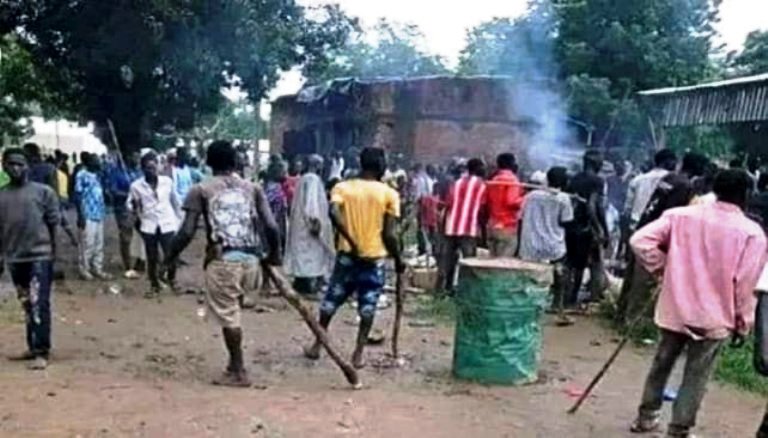Blue Nile Area: Triggers of the tribal conflict
October 26, 2022 (KHARTOUM) – Since July 2022, the Funj and Hausa tribes have been engaged in a bloody conflict, which escalated in September before reaching an unprecedented level in October 2022.
Over 155 people were killed and thousands were displaced during the recent round of violence in the Wad Al Mahi area. The
However, Obaid Abu Shotal, the leader of Hamaj or Funj groups say the Hausa coexist with them for more than 80 years now without problems. He points an accusing finger at some political leaders saying they stand behind the eruption of these bloody attacks that ravaged the region during the last three months.
Abu Shotal recently stated that the conflict aimed to “displace the indigenous people in order to exploit their resources,” alluding to the economic ambitions of some leaders.
Factors that fueled conflict:
The inter-communal clashes erupted due to the Funj rejection to establish a tribal chiefdom for the Hausa. This structure, which would be sanctioned by the regional authority, would enable them to have their own territory in the region and enhance their economic and political influence. The indigenous Funj components oppose the establishment of a Hausa’s Nazarah (chiefdom) saying such a prerogative should not be granted to immigrants who originate from Nigeria.
Also, the split of the Sudan People’s Liberation Movement-North in 2017, and the power struggle between Abdel Aziz al-Hilu and Malik Agar to control the Blue Nile Area has fueled the animosity against the Hausa who are also accused of siding with the former regime.
“The bloody conflict that the region recently witnessed was fueled by political elements, there is no doubt about that,” Babikir Hassan Gadrmari, a professor at the International University of Africa, a Hausa born in Ad Damazin in 1948.
After the signing of the Juba Peace Agreement in October 2020, the Funj component who fought alongside Agar in the region started to express frustration when they saw that Agar and Governor Ahmed Alomda appoint the Angassana at the expense of the other components. Abu Shotal in one of the latest statements claimed to be given 70% of the regional government positions.
According to Gadrmari the antagonism against Agar increased after the peace agreement.
“The Angassana group to which Agar belonged did not have a significant presence in the ranks of the army of the SPLM-N led by Agar. Besides being a minority (in the region), its members are peaceful and do not tend to fight. So, the majority of the movement’s army was from the Funj components, but today they feel injustice and say that the gains of the peace agreement went to the Anqassana. This (bitterness) increased the anger against Agar.”
“The decline in Agar popularity among the Funj led him to forge political alliances with the other groups in the region n order to create a broader social base,” further stressed Gadrmari.
How did disputes erupt between Agar and Abu Shotal?
After the military coup (October 25, 2021), Agar remained in his position as a member of the Sovereign Council based on the Juba Peace agreement and rejected calls to resign in support of the civilian rule. Further, he developed a good relationship with the coup leaders Abdel Fattah al-Burhan and Mohamed Hamdan Daglo “Hemetti”.
This position was a defining moment in Agar’s relationship with the Fung tribal leader, who was the first to criticize him for this “collusion” with the coup leaders and denounced Agar’s harsh criticism of the Resistance Committees’ youth leading the anti-coup protests.
“These boys clapping in the streets are the ones who gave you the opportunity to sign the Juba Peace Agreement, return to the country, and carried you to your position,” Abu Shotal stated in presence of the Blue Nile Resistance Committees in response to Agar’s statements in June 2022.
“What is happening in Sudan is chaos and terrorism against the state, and I do not call it a revolution,” said Agar.
Alternative alliances:
Al-Funj believe that the support the Hausa received from the member of the Sovereign Council in their quest to establish a tribal chiefdom for them in the blue Nile region is evidence of their alliance with Agar.
This was a transgression of the red lines that Abu Shotal drew and defined in the “Historical Legacy” and the “Hawakir“.
As soon as the Hausa and Aqar alliance loomed, the Funj sensed the danger. According to local sources who spoke to the Sudan Tribune: Funj leaders agreed on a plan “to reduce the Hausa’s ambition and prevent them from posing a challenge in the future, nor should they be a supporter to Agar”.
The sources asserted that Funj military elements in the Sudanese army, particularly in the 4th division based in Ad Damazin, and those in the SPLA-N of Agar all of them contributed to attacks on the Hausa people.
Since mid-July, over 70,000 people have been displaced in the Blue Nile region and over 250 people killed.
(ST)

